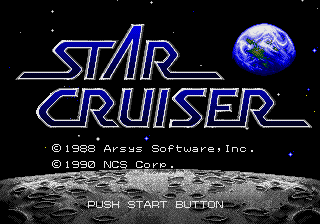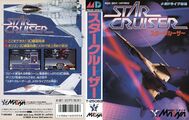Difference between revisions of "Star Cruiser"
From Sega Retro
Scarred Sun (talk | contribs) |
|||
| Line 38: | Line 38: | ||
==Magazine articles== | ==Magazine articles== | ||
{{mainArticle|{{PAGENAME}}/Magazine articles}} | {{mainArticle|{{PAGENAME}}/Magazine articles}} | ||
| + | |||
| + | ==Promotional material== | ||
| + | {{gallery | ||
| + | |{{galleryPrintAd | ||
| + | |Megadrive Fan 1991-01.pdf|mdfan|12|94 | ||
| + | }} | ||
| + | }} | ||
==Physical scans== | ==Physical scans== | ||
Revision as of 21:29, 12 May 2018
This teeny-tiny article needs some work. You can help us by expanding it.
| Star Cruiser | ||||||||||
|---|---|---|---|---|---|---|---|---|---|---|
| System(s): Sega Mega Drive | ||||||||||
| Publisher: Masaya | ||||||||||
| Developer: Arsys Software | ||||||||||
| Genre: Adventure | ||||||||||
| Number of players: 1 | ||||||||||
|
Star Cruiser (スタークルーザー) is a 1990 adventure game for the Sega Mega Drive by Arsys Software, published by NCS. It is a port of Star Cruiser, which was previously released on various Japanese home computers, including NEC's PC-88 and PC-98 in 1988 and the Sharp X68000 in 1989. Ahead of its time, it was a mixture of the action RPG and first-person shooter genres, with the graphics presented in real-time 3D polygon graphics. The Mega Drive version runs the 3D polygon graphics with stock hardware, without using any enhancement chips.
No version has been officially released outside Japan. An English version, retitled Star Quest, was set to be released in North America by Namco in 1994 (being previewed at Winter CES 1993 and Summer CES 1993), but was cancelled for unknown reasons. An English translaton beta patch was released at ROMhacking in September 2016,[1][2] followed by a complete translation patch in November 2016.[3]
A sequel, Star Cruiser II, was released for Japanese home computers in 1992.
Contents
Overview
Upon its original 1988 release, Star Cruiser was an ambitious and innovative game years ahead of its time. The game's innovations included fully 3D polygon graphics (including nearly all objects, enemies, and backgrounds, with the exception of distant horizons that were pre-rendered), true first-person shooter gameplay (anticipating the likes of Wolfenstein 3D and Doom), gameplay mechanics such as strafing, fusion of the first-person shooter and RPG genres (anticipating the likes of System Shock and Deus Ex), real-time 3D first-person movement (unlike earlier first-person games which were pre-computed), 3D open-world exploration across a large game universe (spanning several star systems), 3D space flight simulator segments for exploring outer space with six degrees of movement (and fighting enemy spacecraft), a crosshair to target enemies (both on ground and in space), and a portable computer built into the player character's power suit that has various uses (such as displaying an automap and radar). The game had a large open-world game universe, allowing the player to explore over 30 planets across four star systems, making it the earliest example of a fully 3D polygon open-world game.
The game also emphasized storytelling, with an epic sci-fi space opera storyline set in the 27th century, plot twists, character dialogues with NPCs (who have their own background stories), anime style dialogue portraits for characters, visual novel style first-preson cutscenes, animated cutscenes rendered using the game's 3D engine, and a chiptune soundtrack composed by Toshiya Yamanaka using FM synthesis (later released as a seperate original soundtrack CD).
History
Star Cruiser runs on a 3D polygon engine previously used by the 1986 Arsys Software role-playing shooter Wibarm. While Wibarm only used the 3D engine for exploring indoor environments and presented it in a third-person view, Star Cruiser used the 3D polygon engine for the entire game and presented the view entirely in a first-person view.
Reception
The original home computer releases were critically acclaimed, particularly the Sharp X68000 version, winning a number of awards (including Game of the Year awards) from Japanese publications. However, the Mega Drive port had a mixed reception. In Japan, Famitsu gave it a mixed-to-positive review, considering it to be not as good as the X68000 version. In Europe, import reviews were very critical, not necessarily because of the gameplay, but because of the Japanese text, which was regarded as a major obstacle to playing the game, as some parts of the gameplay rely heavily on understanding Japanese text in order to continue the game. In North America, Electronic Gaming Monthly's reception of the unreleased English version, Star Quest, was positive.[4][5]
Magazine articles
- Main article: Star Cruiser/Magazine articles.
Promotional material
Physical scans
| Sega Retro Average | ||||||||||||||||||||||||||||||||||
|---|---|---|---|---|---|---|---|---|---|---|---|---|---|---|---|---|---|---|---|---|---|---|---|---|---|---|---|---|---|---|---|---|---|---|
|
| 53 | |
|---|---|
| Based on 6 reviews | |
References
NEC Retro has more information related to Star Cruiser
|
- ↑ Star Cruiser, a Japanese exclusive Mega Drive shooter, translated into English, Sega Nerds
- ↑ Star Cruiser Receives English Translation by Fans for Sega Genesis Console, Retro Gaming Mag
- ↑ Star Cruiser, ROMhacking
- ↑ 4.0 4.1 File:EGM US 051.pdf, page 108
- ↑ 5.0 5.1 File:EGM US 059.pdf, page 190
- ↑ File:BeepMD_JP_1991-01.pdf, page 35
- ↑ File:SSM_JP_19950901_1995-09.pdf, page 85
- ↑ 8.0 8.1 File:Joystick FR 014.pdf, page 134 Cite error: Invalid
<ref>tag; name ":File:Joystick FR 014.pdf_p134" defined multiple times with different content - ↑ File:SegaPower UK 46.pdf, page 98
- ↑ Beep! MegaDrive, "January 1991" (JP; 1990-12-08), page 35
- ↑ Famitsu, "" (JP; 199x-xx-xx), page 1
- ↑ Hippon Super, "January 1991" (JP; 1990-12-04), page 40
- ↑ Mega Drive Fan, "March 1991" (JP; 1991-02-08), page 99
- ↑ Sega Power, "October 1991" (UK; 1991-09-05), page 54
- Pages with reference errors
- Sub-stubs
- 1 player games
- JP Mega Drive games
- Mega Drive games
- 1990 Mega Drive games
- All 1990 games
- Mega Drive adventure games
- Use romtable template
- All games
- GalleryPrintAd file defined
- Old-style rating (bemega)
- Use magref
- Old-style rating (bemega r)
- Old-style rating (egm)
- Old-style rating (famitsu)
- External rating reference
- Old-style rating (hippons)
- Rating without PDF source
- Old-style rating (joystick)
- Old-style rating (mdag)
- Old-style rating (segapower)
- Old-style rating (segapro)
- Update ratings template
- 10 old ratings




